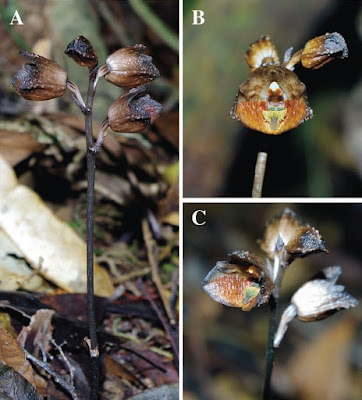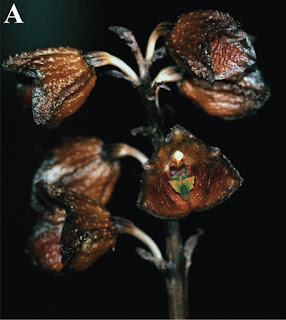Abstract
Gastrodia madagascariensis, a leafless achlorophyllous orchid, is described and illustrated here. The epithet was originally coined by Perrier de la Bâthie in 1939 for fruiting material found on the eastern coastal plain of Madagascar more than a century ago, but the name was never validly published. This new species is closely related to G. similis from Reunion Island, from which it can be distinguished by the perianth tube spreading towards the apex, the shape of the column and stigma, and the flower colour. The achlorophyllous genus Gastrodia currently comprises five species in the tropical parts of the Afro-Madagascan region, one of which, G. africana, is possibly extinct. We provide an artificial key to distinguish them. In addition, there is also an extratropical species in continental Africa, the introduced G. sesamoides (very local near Cape Town, South Africa).
Keywords: Didymoplexis; Flora of Madagascar; myco-heterotrophy; Perrier de la Bâthie, Monocots, Madagascar
Diagnosis:— Similar to Gastrodia similis Bosser (2006: 52), from which it can be distinguished by the perianth tube spreading towards the apex, the cordate stigma, and the emerald green lip colour.
Distribution and habitat:— Gastrodia madagascariensis is only known from Ambodiriana Forest near Manompana (Fig. 3). Here, it grows in evergreen, humid forest below 200 m and is more commonly found in the vicinity of the river Manompana and its tributaries.
Etymology:— The epithet madagascariensis refers to Madagascar, where this species is endemic.
Conclusion:
Since the recent treatment of Gastrodia in Genera Orchidacearum (Kores et al. 2006), the number of species has increased considerably from approximately 20 to 50 species (Hsu & Kuo 2010, 2011, Yeh et al. 2011, Hsu et al. 2012, Tan et al. 2012, Suetsugu 2013, 2014, Hu et al. 2014), making it the most diverse genus in the orchid tribe Gastrodieae. In view of that, investigations into nuclear and mitochondrial markers that would suitably resolve the phylogenetic relationships between the Gastrodia species found in the Asia-Pacific and the Afro-Madagascan region are now needed.
Florent Martos, Steven D Johnson and Benny Bytebier. 2015. Gastrodia madagascariensis (Gastrodieae, Orchidaceae): from An Historical Designation to A Description of A New Species from Madagascar.
Phytotaxa. 221(1): 48–56. DOI: 10.11646/phytotaxa.221.1.4
Phytotaxa. 221(1): 48–56. DOI: 10.11646/phytotaxa.221.1.4
Résumé: Gastrodia madagascariensis, une orchidée aphylle non-chlorophyllienne, est décrite et illustrée ici. L’épithète fut initialement proposé par Perrier de la Bâthie en 1939 pour décrire une plante en fruit trouvée dans la même région côtière de Madagascar il y a plus d’un siècle, mais sa publication était alors invalide. Cette nouvelle espèce est proche de l’espèce G. similis endémique de l’Île de la Réunion, mais s’en distingue toutefois par un calice campanulé, la forme de la colonne et du stigmate, ainsi que la couleur de la fleur. Le gene non-chlorophyllien Gastrodia comprend aujourd’hui cinq espèces en Afrique tropicale et à Madagascar; l’une d’entre elles, G. africana, étant probablement éteinte. Une clé d’identification de ces espèces est proposée ici. De plus, on recense une sixième espèce sur le continent africain, c’est-à-dire l’espèce introduite G. sesamoides (près de la ville du Cap, Afrique du Sud).
Mots-clés: Didymoplexis; Flore de Madagascar; myco-hétérotrophie; Perrier de la Bâthie


